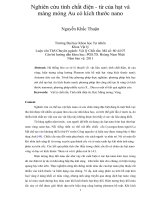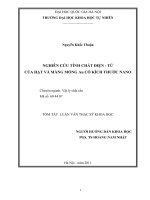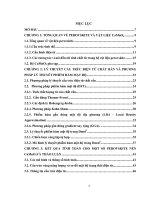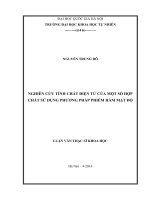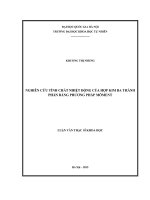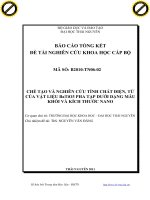DSpace at VNU: Nghiên cứu tính chất điên tử của oxit TiO 2 sử dụng phương pháp phiếm hàm mật độ DFT
Bạn đang xem bản rút gọn của tài liệu. Xem và tải ngay bản đầy đủ của tài liệu tại đây (307.36 KB, 6 trang )
Nghiên cứu tính chất điên tử của oxit TiO2 sử
dụng phương pháp phiếm hàm mật độ DFT
Trần Văn Nam
Trường Đại học Khoa học Tự nhiên
Luận văn ThS Chuyên ngành: Vật lý chất rắn; Mã số 60 44 01 04
Người hướng dẫn: GS. TS. Bạch Thành Công
Năm bảo vệ: 2013
Abstract. Tập trung nghiên cứu ảnh hưởng của sự pha tạp lên hoạt động quang điện
của điện cực TiO2 dựa trên việc nghiên cứu cấu trúc điện tử và sự hình thành các sai
hỏng bề mặt của vật liệu TiO2 pha tạp một số nguyên tố kim loại khác nhau. Qua đó
chỉ ra các ảnh hưởng tích cực và tiêu cực của việc pha tạp tới hiệu suất của pin mặt
trời DSSC.
Keywords. Vật lý chất rắn; Điện cực; Tính chất điện tử; Oxit TiO2; Pin mặt trời.
Content
MỞ ĐẦU
TiO2 là một trong các oxit kim loại thu hút được rất nhiều sự quan tâm của các nhà
khoa học nhờ sở hữu các tính chất có tính ứng dụng cao như là: tính quang xúc tác mạnh, ổn
định về mặt hóa học, tính siêu thấm ướt và đặc biêt là khả năng phân tách phân tử nước thành
oxy và hydrogen thông qua phản ứng quang điện hóa. Không những vậy, đây cũng là một vật
liệu giá rẻ nên nó được ứng dụng ở nhiều lĩnh vực trong đời sống như chế tạo tạo pin quang
điện hóa học, sử dụng trong các lĩnh vực diệt khuẩn hay để chế tạo các vật liệu tự làm sạch.
Trong những năm gần đây các nhà khoa học đã phát hiện ra một ứng dụng khác cho vật liệu
TiO2, đó là sử dụng các màng TiO2 anatase để chế tạo các pin mặt trời sử dụng chất nhạy màu
viết tắt là DSSC (Dye-Sensitized Solar Cell). Sự ra đời của pin mặt trời sử dụng chất nhạy
màu đã hứa hẹn là một loại pin mặt trời rẻ tiền hơn nhiều so với pin mặt trời truyền thống.
Hiện nay, hệ pin mặt trời này đã đạt hiệu quả chuyển hóa đến 11% và một độ bền rất cao khi
được chiếu sáng trong một khoảng thời gian dài.
Tuy nhiên hiệu suất chuyển đổi năng lượng của loại pin mặt trời này chưa cao, và phụ
thuộc rất nhiều vào khẳ năng hấp thụ quang học của chất nhạy màu cũng như khẳ năng truyền
điện tử từ chất màu qua lớp bán dẫn đến điện cực. Do đó nâng cao hiệu suất chuyển đổi năng
lượng là vấn trọng tâm trong các nghiên cứu về pin mặt trời DSSC. Có khá nhiều hướng
nghiên cứu khác nhau nhằm giải quyết vấn đề này như: Chế tạo các chất nhạy màu toàn sắc,
sử dụng các chất nhạy màu là các chấm lượng tử, nghiên cứu phát triển các màng TiO2 xốp,
sử dụng chất nhạy màu dạng rắn hoặc đưa các nguyên tố tạp vào điện cực TiO2 nhằm thay đổi
cấu trúc điện tử hoặc tính chất điện hóa bề mặt của điện cực. Trong luận văn này, chúng tôi
tập trung nghiên cứu ảnh hưởng của sự pha tạp lên hoạt động quang điện của điện cực TiO2
dựa trên việc nghiên cứu cấu trúc điện tử và sự hình thành các sai hỏng bề mặt của vật liệu
TiO2 pha tạp một số nguyên tố kim loại khác nhau. Qua đó chỉ ra các ảnh hưởng tích cực và
tiêu cực của việc pha tạp tới hiệu suất của pin mặt trời DSSC.
Luận văn gồm có 3 chương
Chương 1 - Tổng quan về pin mặt trời DSSC và vật liệu TiO2
Chương 2 - Giới thiệu vềcác phương pháp tính toán cấu trúc điện tử và phương
pháp lý thuyết phiếm hàm mật độ.
Chương 3 - Kết quả và thảo luận
Reference
TÀI LIỆU THAM KHẢO
Tiếng anh
1. A. S. Rao and R. T. Keamey (1979), "Logarithmic derivative reflectance spectra of
BaO and SrO", Phys. Status Solidi B, 95, pp. 243.
2. A. Si risuk, E. Klansorn and P. Praserthdam (2008), "Effects of reaction medium and
crystallite size on Ti3+ surface defects in titanium dioxide nanoparticles prepared by
solvothermal method", Catalysis Communications, 9, pp. 1810.
3. A. Vittadini, A. Seloni, F.P. Rotzinger, M. Grätzel (1998), "Structure and Energetics
of
Water Adsorbed at TiO2 Anatase \(101\) and \(001\) Surfaces", Phys. Rev. Lett, 81, pp. 2954.
4. B. Baumeier, P. Krüger and J. Pollmann (2007), "Bulk and surface electronic
structures
of alkaline-earth metal oxides: Bound surface and image-potential states from first
principles", Phys. Rev. B, 76, pp. 205404.
5. B. O‟Regan, M. Grätzel (2001), "Photoelectrochemical cells" Nature, 414, pp. 338
6. B. O‟Regan and D. T. Schwartz (1996), "Efficient dye‐sensitized charge separation
in a
wide‐band‐gap p‐n heterojunction", J. Appl. Phys, 80, pp. 4749.
7. Bing Tan and Yiying Wu (2006), "Dye-sensitized solar cells based on anatase TiO2
nanoparticle/nanowire composites", J. Phys. Chem, 110, pp. 15932-15938.
8. D. Duonghong, N. Serpone and M. Grätzel (1984), "Integrated Systems for Water
Cleavage by Visible Light; Sensitization of TiO2 Particles by Surface
Derivatization with Ruthenium Complexes", Helv.Chim.Acta, 67, pp. 1012.
9. D. Monroe (1985), " Hopping in Exponential Band Tails", Phys. Rev. Lett, 54, 146.
10. Delley. B. J (1990), "An All-Electron Numerical Method for Solving the Local
Density Functional for Polyatomic Molecules", Chem. Phys, 92, pp. 508.
11. Ermer. O (1976), "Calculation of molecular properties using force fields.
Applications in organic chemistry", Struct. Bond, 27, pp. 161.
12. H. Kusama, H. Orita, Hideki Sugihara (2008), "DFT investigation of the TiO2 band shift
by nitrogen-containing heterocycle adsorption and implications on dyecell performance", Solar Energy Materials & Solar Cells, 92,
sensitized solar
pp. 84–87
13. H. Rensmo, K. Keis, H. Lindstrom, S. Sodergren, A. Solbrand, A. Hagfeldt, S.E.Lindquist, L.N. Wang and M. Muhammed (1997), "High Light-to-Energy
Conversion Efficiencies for Solar Cells Based on Nanostructured ZnO
Electrodes", J. Phys. Chem.B, 101, pp. 2598.
14. Hohenberg. P. and Khon. W. (1964), "Inhomogeneous electron gas", Phys. Rev.B,
136,
pp. 864-871
15. I. Bedja, S. Hotchandani, P.V. Kamat (1994), "Preparation and Photoelectrochemical
Characterization of Thin SnO2 Nanocrystalline
Semiconductor Films and Their
Sensitization with Bis(2,2'-bipyridine)(2,2'- bipyridine-4,4'-dicarboxylic acid)ruthenium(II)
Complex", J. Phys.Chem, 98,
pp. 4133.
16. J. E. Jaffe, R. Pandey and A. B. Kunz (1991), "Efficient pseudopotentials for planewave calculations", Phys. Rev. B, 43, 1993–2006.
17. J. Koo, S. Kim, S. Jeon and H. Jeon, Y. Kim, Y. Won (2006), "Characteristics of
Al2O3 Thin Films Deposited Using Dimenthylalumium Isopropoxide and
Rimethylalumimum Precursors by the Plasma-Enhanced Atomic-Layer
Deposition
Method ", Journal of the Korean Physical Society, 48, pp. 131.
18. J. Liu, H. Yang, W. Tan, X. Zhou, Y. Lin (2010), "Photovoltaic performance
improvement of dye-sensitized solar cells based on tantalum-doped TiO2 thin
films", Electrochimica Acta, 56, pp. 396.
19. J. C. Slater (1929), "The Theory of Complex Spectra", Phys. Rev. 34, pp. 1293
20. K. H. Ko, Y. C. Lee, Y. J. Jung (2005), " Enhanced efficiency of dye-sensitized
TiO2 solar cells (DSSC) by doping of metal ions", Journal of Colloid and Interface
Science, 283, pp. 482.
21. K. Hara, K. Sayama, Y. Ohga, A. Shinpo, S. Suga, H. Arakawa (2001), " A
derivative dye sensitized nanocrystalline TiO2 solar cell having a high
coumarin-
solar-energy
conversion efficiency up to 5.6%", Chem. Commun, 6, pp. 569-570
22. K. Hara, M. Kurashigo, Y. Dan-oh, C. Kasasa, Y.Ohga, A. Shinpo,S. Suga, K.
Sayama, H. Arakawa (2003), "Design of new coumarin dyes having thiophene
moieties for highly efficient organic-dye-sensitized solar cells", New J. Chem,
27,
pp. 783.
23. K. J. Chang, S. Froyen and M. Cohen (1983), "The electronic band structures for
zincblende and wurtzite BeO", J. Phys. C, 16, pp. 3475.
24. K. Sayama, H. Sugihara and H. Arakawa (1998), "Photoelectrochemical Properties
of a
Porous Nb2O5 Electrode Sensitized by a Ruthenium Dye", Chem. Mater, 10, pp. 3825.
25. K. Tennakone, G.R.R. Kumara, I.R.M. Kottegoda, V.S.P. Perera (1999), "An efficient
dye-sensitized photoelectrochemical solar cell made from oxides of tin
and zinc", Chem.
Commun, 1, pp. 15-16.
26. Kohn, W. and Sham, L, J (1965), "Self-consistent equations including exchange
and
correlation effects," Phys. Rev, 140, pp. 1133-1138.
27. L. H. Thomas (1927), "The calcualtion of atomic fields", Proc. Cambridge Phil.
Roy. Soc, 23, pp. 542-548
28. L. Thulin and J. Guerra (2008), " Calculations of strain-modified anatase TiO2
band structures", Phys. Rev. B, 77, pp. 195112.
29. M. Adachi, Y. Murata, T. Okada and Y. Yoshikawa (2003), "Formation of Titania
Nanotubes and Applications for Dye-Sensitized Solar Cells", J. Electrochem.
Soc,
150, pp. 488.
30. M. Calatayud, P. Mori-Sánchez, A. Beltrán, A. Martín Pendás, E. Francisco, J.
Andrés and J. M. Recio (2001), "Quantum-mechanical analysis of the equation
of
state of anatase TiO2", Phys. Rev. B, 64, pp. 184113.
31. N. Jenny (1999), "Continuous-time random-walk model of electron transport in
nanocrystalline TiO2 electrodes", J. Phys. Rev. B, 59, pp. 15374–15380.
32. P. D. C. King, T. D. Veal, A. Schleife, J. Zúñiga-Pérez, B. Martel, P. H. Jefferson,
Fuchs, V. Muñoz-Sanjosé, F. Bechstedt and C. F. McConville1 (2009),
electronic structure of CdO, ZnO, and MgO from x-ray
F.
"Valence-band
photoemission spectroscopy and
quasi-particle-corrected density-functional theory calculations", Phys. Rev. B, 79, pp.
205205.
33. Perdew J. P. (1986), "Density-functional approximation for the correlation-energy
of
the inhomogenous electron gas", Phys. Rev. B, 33(12), pp. 8822-8824.
34. Perdew J. P. and Zunger A. (1981), "Self-interaction correction to density-
functional
approximations for many-electron systems", Phys. Rev. B, 23, pp. 5048-5079.
35. Perdew J. P. and Wang Y. (1986), " Accurate and simple density functional for the
electronic exchange energy: Generalized gradient approximation", Phys. Rev. B,
33(12), pp. 8800-8802.
36. Perdew J. P., Burke K. and Ernzerhof M. (1996), " Generalized Gradient
Approximation Made Simple", Phys. Rev. Lett, 77, pp. 3865-3868.
37. R. Asahi, Y. Taga, W. Mannstadt and A. J. Freeman (2000), " Electronic and optical
properties of anatase TiO2", Phys. Rev. B, 61, pp. 7459.
38. R. Sanjinés, H. Tang, H. Berger, F. Gozzo, G. Margaritondo, and F. Lévy (1994),
"Electronic structure of anatase TiO2 oxide", J. Appl. Phys, 75, pp. 2945.
39. R.Dabestani, A.J.Bard, A.Campion, M.A.Fox, T.E.Mallouk, S.E.Webber and J.M.White
(1988), "Sensitization of Titanium Dioxide and Strontium Titanate Electrodes by
Ruthenium(II)tris(2,2'-bipyridine-4,4'-dicarboxylic acid) and Zinc Tetrakis(4carboxyphenyl)Porphyrin: An Evaluation of Sensitization Efficiency
Photoelectrodes in a Multipanel Device", J. Phys. Chem, 92, pp.
for Component
1872.
40. Robert. G. Parr and Weutao Yang , “Density – Functional Theory of atoms and
molecules”, Oxford university Press, 51 Newyork Clarendon Press.
42. Roothaan (1951), "New Developments in Molecular Orbital Theory", Rev. Mod.
Phys, 23, pp. 69–89.
42. Roothaan (1960), " Self-Consistent Field Theory for Open Shells of Electronic
Systems", Rev. Mod. Phys, 32(2): pp. 179–185.
43. S. D. Mo and W. Y. Ching (1995), "Electronic and optical properties of three phases of
titanium dioxide: Rutile, anatase, and brookite", Phys. Rev. B, 51, pp.
13023.
44. S.D. Burnside, V. Shklover, Ch. Barbé, P. Comte, F. Arendse, K.Brooks, M. Grätzel
(1998), "Self-Organization of TiO2 Nanoparticles in Thin Films", Chem.
Mater, 10, pp.
2419.
45. Sundström, et al (2002), "Photoinduced Ultrafast Dye-to-Semiconductor Electron
Injection from Nonthermalized and Thermalized Donor States", J. Am. Chem.
124, pp. 489.
Soc,
46. T. Nikolay, L. Larina, O. Shevaleevskiy and B. T. Ahn (2011), "Electronic
structure
study of lightly Nb-doped TiO2 electrode for dye-sensitized solar cells", Energy Environ.
Sci, 4, pp. 1480-1486
47. T. Umebayashi, T. Yamaki, H. Itoh, K. Asai (2002), "Analysis of electronic
of 3d transition metal-doped TiO2 based on band calculations",
structures
Journal of Physics and
Chemistry of Solids, 63, pp. 1909.
48. V. Shklover, Yu.E. Ovchinnikov, L.S. Braginsky, S.M. Zakeeruddin,M. Grätzel
(1998), "Structure of Organic/Inorganic Interface in Assembled Materials Comprising
Molecular Components. Crystal Structure of the Sensitizer Bis[(4,4„-carboxy-2,2„bipyridine)(thiocyanato)]ruthenium(II)", Chem. Mater,
10, pp. 2533.
49. W. J. Yin, S. Chen, J. H. Yang, X. G. Gong, Y. Yan and S. H. Wei (2010),
band gap narrowing of anatase by strain along a soft crystal
"Effective
direction", Appl. Phys.
Lett, 96, pp. 221901.
50. X. Lu, X. Mou, J. Wu, D. Zhang, L. Zhang, F. Huang, F. Xu and S. Huang (2010),
"Improved-Performance Dye-Sensitized Solar Cells Using Nb-Doped TiO2
Electrodes: Efficient Electron Injection and Transfer", Adv. Funct. Mater, 20,
509.
51. Yyexiang Li, Shaoqin Peng, Fengyi Jiang, Gongxuan Lu and Shuben Li. J. Serb
(2007), "Effect of doping TiO2 with alkaline-earth metal ions on its
photocatalytic activity", Chem. Soc, 72(4), pp. 393–402.
pp.
